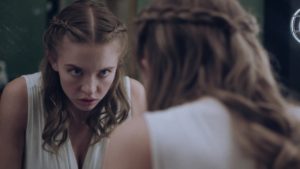
Over the past few weeks, Blumhouse Pictures and Amazon Prime Video have been releasing a series of horror-thrillers under the umbrella “Welcome to the Blumhouse,” featuring four relatively new filmmakers showing off their skills within a specific genre.
Veena Sud’s The Lie reunites the director with Mireille Enos, the star of her AMC series The Killing, as it shows what happens when her character’s teen daughter Kayla (played by Joey King) meets a classmate on the way to camp, and when that friend disappears, the girl’s mother and father (Peter Sarsgaard) are forced to cover up to protect their daughter. Sud adapted it from a German film called We Monsters.
Emmanuel Osei-Kuffour, Jr’s Black Box is a sci-fi tinged thriller starring Mamoudo Athie as Nolan, a man who has lost his memory in a car crash that’s taken the life of his wife. Trying to connect with the daughter (Amanda Christine) he doesn’t remember, Nolan goes to a specialist (Phylicia Rashad) who seems to have the technology to restore Nolan’s memory… but at what cost?
Elan and Rajeev Dassani’s Evil Eye stars Sarita Choudhury and Sunita Mani (GLOW) as mother-daughter Usha and Pallavi, separated by the former being in India and the latter being in New Orleans. Usha wants her daughter to find a suitable husband but when Pallavi moves in with the handsome and well-to-do Sandeep (Omar Maskati), Usha believes that the man has a dark secret connected to her own past.
Last and certainly not least is Zu Quirke’s Nocturne, the one fully original piece in the first half of the series, both written and directed by Quirke. Nocturne stars Sydney Sweeney and Madison Iseman as Juliet and Vivian, competitive musical sisters vying for the same solo seat at their music academy. Vivian always seems to get everything she wants from life, and Juliet is clearly jealous until she finds a way to start getting what she wants, but with deadly results.
What’s interesting is that three of the films were shot in New Orleans using the same crew, filming back-to-back, with the only exception being Sud’s film, which actually premiered at the 2018 Toronto International Film Festival.
Below the Line had a chance to speak to all five filmmakers over the past few weeks. Note: Although this feature is fashioned as a roundtable, we spoke to all of the filmmakers separately.
Connecting with Blumhouse and Amazon
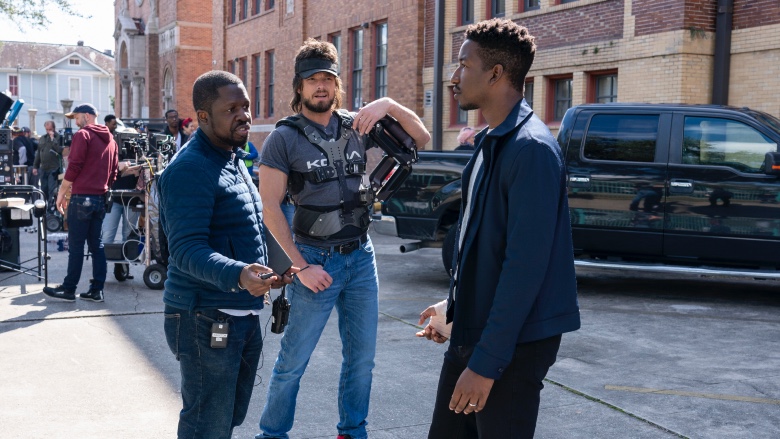
Emmanuel Osei-Kuffour, Jr.: [Blumhouse] had been developing it, and they found my short film, Born with It, and they thought my sensibility would lend itself well to Black Box. I remember reading it and being really excited by the concept of a Black Box, and the relationship between Nolan and his daughter and just such devotion to get better for his daughter. I thought I could add more to it, and really elevate the story by telling a story about a deeply-flawed man, that is forced to confront his past in order to become a better man, so he can have a second chance to become a better father. The idea of somebody getting a second chance to become a better father was just something that was really personal to me, and something I thought would be a really moving journey to see on screen. Luckily, Blumhouse and Amazon agreed and chose to hire me to rewrite and direct it.
Zu Quirke: I wrote the script by myself in my little flat in London a few years ago, and Blumhouse and Amazon got hold of the script when they were putting together Welcome to the Blumhouse, and they got in contact to talk about possibly making it over in the US. I had been developing it over in the UK, and I realized that it’s a universal story, and it could transplant very well over here.
Elan Dassani: At the beginning, it was an Audible Play. Madhuri Shekar, the writer, wrote a screenplay for it, and I believe that Priyanka Chopra‘s company, Broke Pebble, brought the project to Amazon and Blumhouse, and it then became part of this larger Welcome to the Blumhouse slate of films. We pitched after it was already part of the slate, so we came in as directors, basically pitching on the script that was already written. What we brought to the table was that it was originally an audio play, so it was all phone calls. Part of the pitch was, “How do you make this cinematic?” A lot of it had to do with adding more visual representations of the obsessions, like the flashbacks, the underwater sequence, bloody knives and that kind of imagery. Some of that was in there, but we put a lot more of that to give us a more of a visual flair and visual storytelling.
Rajeev Dassani: We worked with Madhuri to add those visual elements, but we also were working with them on the story itself, in terms of making it so that some interactions that were only over phone calls happen together.
The Look of the Films
Despite three of the films sharing the same crew, each one has a very distinctive look that can be traced back to various creatives who worked with the filmmakers.
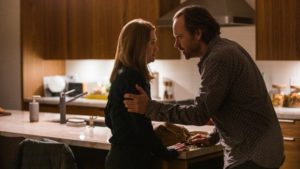
Veena Sud: [Cinematographer] Peter [Wunstorf] and I’ve worked together on The Killing. We were in challenging outdoor Vancouver weather. Toronto clearly is much more challenging, because it was the wintertime there, and it was negative 40 degrees on some days. Peter and I had a very clear vision together of what we wanted, and we pre-shot some scenes on an iPad, with the Artemis that we were using. The house itself was where we were a solid 80% of the time of this movie, so we had to avoid repetition. We had to really be rigorous in shots, and Elisa Sauve, our production designer, was so detail-oriented and what would be in every single frame from a fogged-up glass to curtains that are sheer-white that still let the outside in.
Quirke: A lot of [the film’s look] is thanks to our wonderful DoP Carmen Cabana. She’s done a lot of incredible work on TV in particular, High Fidelity and Narcos. We had a Skype, and we just geeked out over the East Asian cinema over Park Chan-wook and Satoshi Kon, great Koreans in particular. We really met in terms of how we saw the movie and how we wanted to style it together. So the visuals are largely Carmen’s creation that I’m super happy with them. We had an extensive reference book of shots that we drew from, and she was wonderful all the way through the process. A lot of it is a mixture of in-camera kind of bolstered by post. We were moving very quickly. We had 20 days to shoot in and 50 to 60 setups on any one day. Sometimes we had to boot things into post, if we couldn’t get quite the look we wanted or the lighting stuff that we wanted. I would always take more time over more money.
Elan: It was almost like a TV series type of shooting where it’s a singular crew — they were wonderful. We were so impressed by our Production Designer Roger Dwyer and costumes. They really stepped up, because one of the hard things about this movie is it’s 90% shot in New Orleans, but it’s 50% set in India. All of it had to be completely designed from scratch, like all the Indian interiors had to be authentic and that meant a lot of research into how a sari is tied. Even down to things like the power outlets in India look totally different, so they were 3D-printing special power outlets to put on the wall.
Rajeev: The hardest job here was the production designer’s job and the art department, because they basically had to recreate Delhi in a little chunk of New Orleans. I think for them it was a fun challenge. A lot of the set designers and set decorators said, “Oh, if we have to dress one more police station, we’ll kill ourselves.” Doing a New Delhi apartment was fun, because we found photos online, but we didn’t think they were good, so we called our parents and our cousins and asked, “Could you take photos of your living room and your kitchen and your bedroom?” The props guys had a scene with all of the albums of photos, and he said, “I don’t know where I’m going to get photos for all this stuff.” So we asked our dad to send all of our family photos, so every other photo in that album is like us or our Dad or our Mom.
Sud: Thematically, this is the story of a family living inside a glass house where a crime is committed and now everyone can see in, and the growing paranoia over the course of five days of the fact that they can’t hide. We step that through literally. We did storyboards on how the house deteriorates inside. Leslie Kavanagh, who did wardrobe, and my incredible makeup and hair women, we talked about how skin falls apart, how hair falls apart, bags under the eyes when you’re not sleeping. We talked about even the Venetian blinds, a nod to Hitchcock when they close and open and when she lets the light in and when she closes them. The growing darkness inside the house as this drama on unspools. All of us had a very clear arc in the look, and the look had to be in concert with all the departments creating slow, inevitable chaos inside this house, a much more realistic and lighter version than [Repulsion], the Roman Polanski movie with Catherine Deneuve, where she’s going crazy in the house and things come out of the walls. Our real-life version of that was to feel that claustrophobia in a white house. Elisa was so wonderful in her eye, because even inside the house, you may not have noticed or maybe subconsciously, the wall is curved. There are clean lines, but there’s one curve in a wall that’s a little bit off-putting. We would play with Artemis for hours, and what is the exact camera position you need to be in to feel that curve like coming at you.
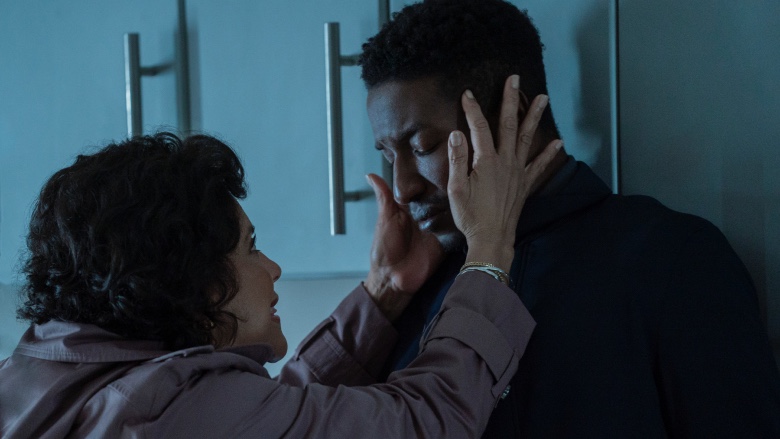
Osei-Kuffour, Jr.: The technology inside the Black Box is obviously futuristic, but the direction I gave to all the department heads was to really make it as slice of life and as grounded as possible. Especially with production design, I wanted it to feel like there was a world that existed outside of this film, and I gave a lot of references. Pursuit of Happiness was a great reference for the production designers. Black Swan was also a great reference for the designers, because I always pitched this film as a mix between the two of those films. Pursuit of Happiness for obvious reasons, and Black Swan because just the way that character in the film constantly questions her reality and identity. I felt like there are details and there’s texture in both of those films that really suggests the world outside the frame, so even the wardrobe and hair, like everything was telling the story for me. When I was trying to figure out how to bring this to life, I just felt like pushing in and pulling out and making the transitions as seamless as possible, because it felt dreamy, and it felt like sudden, and it felt like more of a surprise to do it that way. To my knowledge, I don’t think there was a reference for that, specifically, there was a reference for the moments where he’s being pulled into the memories. I always wanted that to feel really visceral and jarring, and so I looked at The Matrix and The Butterfly Effect.
Elan: Our DP, Yaron Levy, he convinced us to use one camera instead of two, which was very unique. Usually, a film like this has two or three cameras. We use one almost the entire time, and it meant we could be much more intentional with our lensing. During a phone call when they’re in opposition, we would have the mom frame right looking right, and the daughter framed left looking left. They’re actually looking away from each other. When they’re connected, we would have the daughter frame left looking right, so one feels like there’s a connection. That was a fascinating tool to deploy. We only used a split screen one time the entire film, which is very much intended. We wanted to use it once to give an incredible emotional impact and never use it again.
The Sound and Music
Likewise, each film has a distinct sound either due to sound design, music or both.
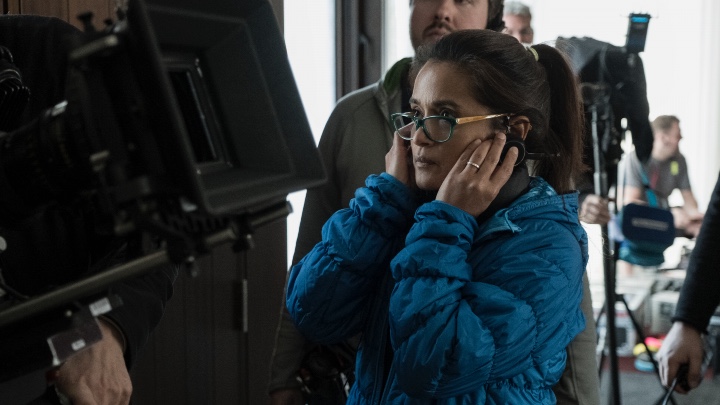
Sud: Tamar- Kali was our composer, who did Mudbound. The number one approach all of us had from prep to post was, “What is the human element behind the story?” It already has built-in psychological terror, because of this family hiding out in this house because of a crime that their child committed and something might be wrong with the child. So how do I balance that with just the human aspects? So Tamara and I talked a lot about just making the music just… it’s a family drama. It’s a story about people. It’s a love story between a mother and her child and the father and his child. And how does the score reflect that? Phil Fowler was my editor and he came up on The Killing. We did Seven Seconds together. He cut The Salton Sea. It’s just the quiet unspooling of a moment was such a challenge for editing, too, because how long do you hold the shot without like driving people crazy? So that kind of timing was so critical, and Phil is such a genius.
Osei-Kuffour, Jr.: The sound designer was the same thing — I wanted everything to feel grounded, and organic. I thought he did a really good job of just bringing that world to life. A lot of what we did in the film was referenced from Black Swan as far as sound design and composing goes. I wanted it to feel a little retro, but I also wanted it to feel ’80s ’90s it’s funny to say 90s is retro, but I wanted it to feel like Jacob’s Ladder a little bit, and then I forget the other references I had for the composition, but Brandon [Roberts] was incredible. Us was also another reference. Ringu, as well, and I like this other film by that director, Dark Water. I think that is organic, almost ethereal, like nature-driven on the works of Kenji Kawai.
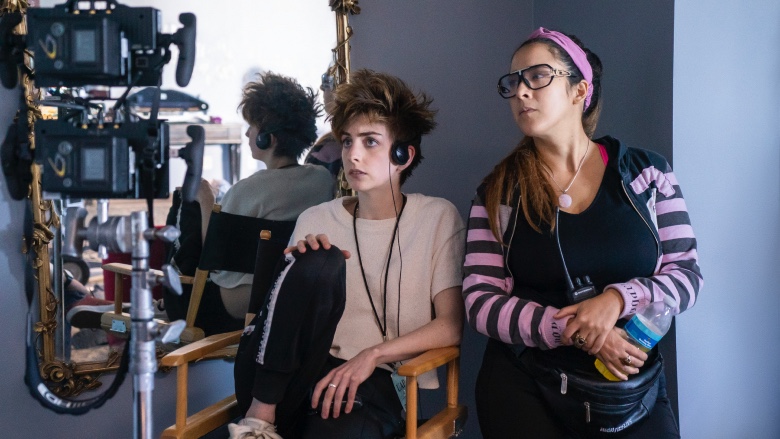
Quirke: It was important to me from the start, that we not fall into the trap of making this a purely classical film. It’s about kids, and I wanted to represent that in the score. One of the central dichotomies of the film is that you’ve got these young kids who should be listening to electronic music, are instead playing classical. In their spare time, they’re not going home and listening to Stravinsky or Prokofieff, they’re going home and listening to whatever the music on the radio is. I wanted to reflect that in the score, and I discovered Elizabeth Bernholz, our composer, when I was back in the UK. She’s an incredible electronic music producer under her label, Gazelle Twin, and I could just hear the devil in her music. It sounded like nobody I had ever heard before. She had such a very specific sound. I contacted her, and she was up for it. I think this was one of the first movies in the US that she’d scored. She was working from the UK and sending us things. Besides the time difference, it worked out really beautifully. I’m very proud of the score. I think it’s different, I think it’s unexpected in places, and I think Elizabeth did an incredible job.
Doing Post During a Pandemic
The filmmakers behind Evil Eye spoke to us a bit about what was involved with getting their film finished once the pandemic hit.
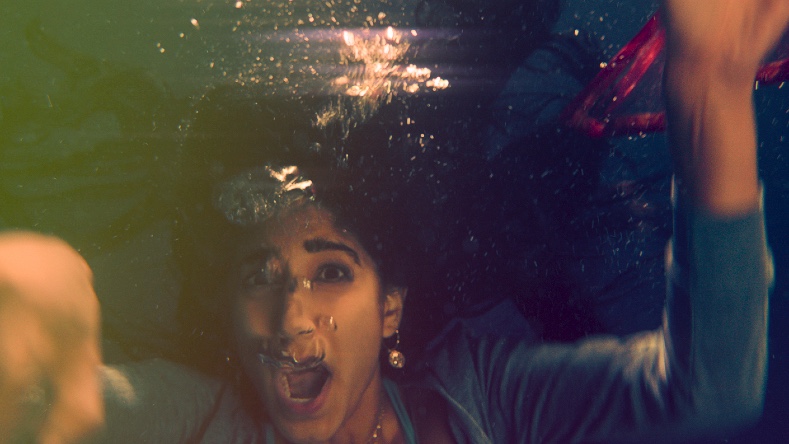
Elan: We had managed to finish most of the editing just prior to quarantine. Essentially COVID hit and we had to stop coming into the edit room completely. Luckily, we could do most of our editorial in person with our Editor Kristina [Hamilton-Grobler] who was wonderful. After that, all of the sound work, color, VFX were all done remotely over Zoom.
Rajeev: What was strange, is that because this was the time right when everyone was at home. Luckily, the colorist had a home setup, so he was coloring our movie at home and sending us cuts. We would make notes and the sound designer had his own shop up in Burbank, and he did the same thing.
Elan: I have to say that the sound was probably the most difficult only because we were only once able to go in and actually sit in a 5:1 stage and listen. Most of the time we were listening essentially on our laptop, which is not the same. He did his best, but we followed a lot of very careful protocol, so when we went in to listen to it, he left the room, he sanitized it, then we went in and listened to it. Then we left, and it got sanitized again. It was very, very involved.
The first four Welcome to the Blumhouse films – The Lie, Black Box, Nocturne and Evil Eye – are all available to stream on Amazon Prime Video. Four more films in the series will be released in 2021.





